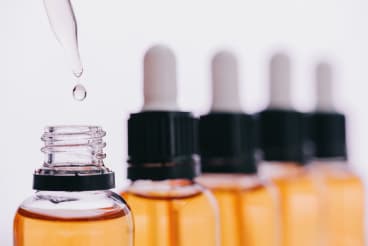 Benzoyl Peroxide
Benzoyl PeroxideHow To Treat Adult Acne In Men
Thought you’d left your breakouts in your teenage years? Yeah, us too. Here’s what you need to know about keeping your complexion clear in adulthood.
November is Men’s Health Awareness Month, and we’re spotlighting issues that are often dismissed or under-discussed in male personal care. According to a study in the Journal of the American Medical Association, 40 to 54 percent of adults over the age of 25 have some degree of facial acne. By the time we reach middle age, the skin condition is more present in women (12 percent) than men (3 percent). Acne grows rarer as we get older, but the emotional toll of breaking out may not.
Though many facets of acne treatment are the same regardless of sex, the causes and some of the solutions can differ. We spoke to board certified dermatologists to learn more about the specifics of adult acne in men.
What Causes Acne in Men?
In all genders, acne is caused by an interplay of several factors: skin bacteria, excess oil production, irregularities in skin cell turnover that contribute to blocked pores and inflammation, says Brendan Camp, MD, a board certified dermatologist in New York City. In men, groupings of steroid hormones called androgens (of which testosterone is one) can also cause increases in oil production and inflammation, which can lead to breakouts.
Adult acne is more likely to stem from lifestyle factors like stress, diet, and grooming habits, along with genetic predisposition, says Rachel Maiman, MD, a board certified dermatologist in NYC. Simple personal care changes, like always showering after exercise or changing the pillowcases more often, can help prevent breakouts. Because beards and mustaches can house acne-causing bacteria and trap oil, good grooming habits are especially important for men with facial hair. In Dr. Maiman’s practice, men “have a greater tendency to choose harsh skincare products” that cause irritation and inflammation and, thus, acne. That’s another way of saying: Guys, start following Dewy Dudes on Instagram and get your skincare regimen tight.
As Dr. Maiman points out, not every breakout or skin irritation is actually acne. In the beard area, breakouts may be a symptom of pseudofolliculitis barbae, which is caused by beard hair growing back into the skin. Treatment may differ from that of traditional acne, so, if you’re dealing with a beard breakout, talk to a dermatologist who can make the distinction.
How to Treat Acne in Men
Treating acne is a delicate balance. “The most important part about treating acne is being consistent with a treatment regimen but not overdoing it,” Dr. Camp shares. Since acne is a chronic issue, it’s often necessary to continue treatment even once the active breakouts are cleared. “Many patients will stop treatment once their skin is improved, only to have a flare again,” he says. On the other hand, some patients are overzealous with treatment, thinking that more medication will accelerate acne-clearing. Too much washing, too many spot treatments, or too vigorous exfoliation will cause more skin irritation and make breakouts worse.
When building a treatment plan, a dermatologist will take into consideration the type of acne and its location on the body. According to Kristen Aloupis, MD, board certified dermatologist in Jupiter, Florida, comedonal acne (small, flesh-colored bumps) is often treated with a prescription of tretinoin, a topical Retin A cream that increases cell turnover. For papular pustular acne (larger bumps and pimples), a short period of oral antibiotics may be prescribed at first to get the acne under control.
In conjunction with prescription medications, a dermatologist will help determine a carefully curated daily skincare regimen. Dr. Maiman recommends looking for cleansers that feature salicylic acid in concentrations of 2 or 3 percent, which is often “an effective first trail for those with mild acne.” For patients with sensitive skin, she advises using a glycolic acid cleanser instead. If you're looking for specifics, the La Roche-Posay Effaclar Medicated Gel Cleanser features 2 percent salicylic acid, while the Glytone Mild Cream Cleanser has a fairly mild concentration (3.4 percent, to be exact) of glycolic acid.
Other helpful topical ingredients — especially for inflammatory acne — are benzoyl peroxide, sulfur, and niacinamide. When it comes to niacinamide, lots of acne-specific products contain the skin-soothing ingredient, but we’re fans of the Algenist Algae Niacinamide Moisture Veil for its ability to reduce excess surface oil and shine while fortifying the skin barrier. The Paula's Choice Regular Strength Daily Skin Clearing Treatment has 2.5 percent benzoyl peroxide to treat mild to moderate acne without dryness and irritation. The Kate Somerville EradiKate Acne Treatment, meanwhile, is a sulfur-based spot treatment.
Last but not least, the backbone of any adult acne regimen, Dr. Maiman says, is a retinoid. It can be delivered through an over-the-counter product, like Differin Gel, or in a prescription-strength formula.
The Takeaway
As with treating any skin concern, the most precise regimen should come from your board certified dermatologist. Depending on the acne at hand, a treatment plan may include antibiotics, daily medication, prescription topicals, or even just a simple acne-fighting cleanser.
All products featured are independently selected by our editors, however, AEDIT may receive a commission on items purchased through our links.
More Related Articles
Related Procedures

AI Plastic Surgeon™
powered by'Try on' aesthetic procedures and instantly visualize possible results with The AI Plastic Surgeon, our patented 3D aesthetic simulator.


